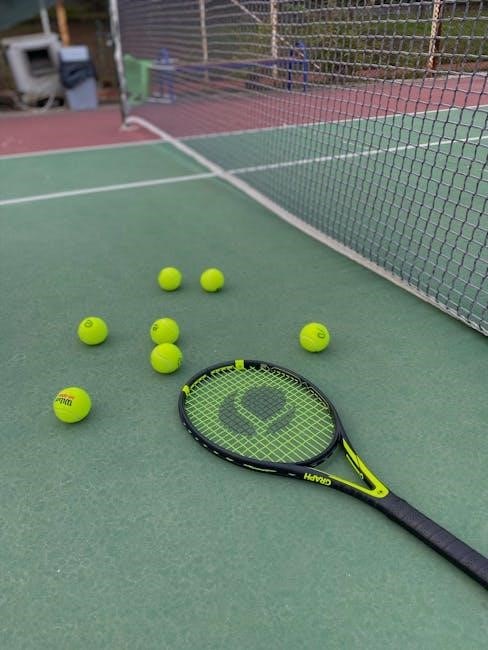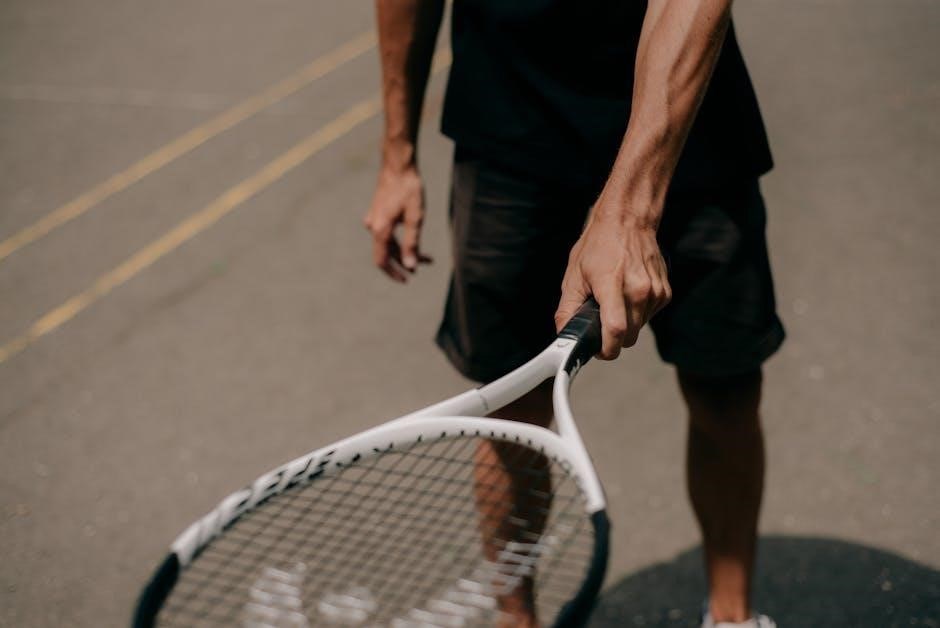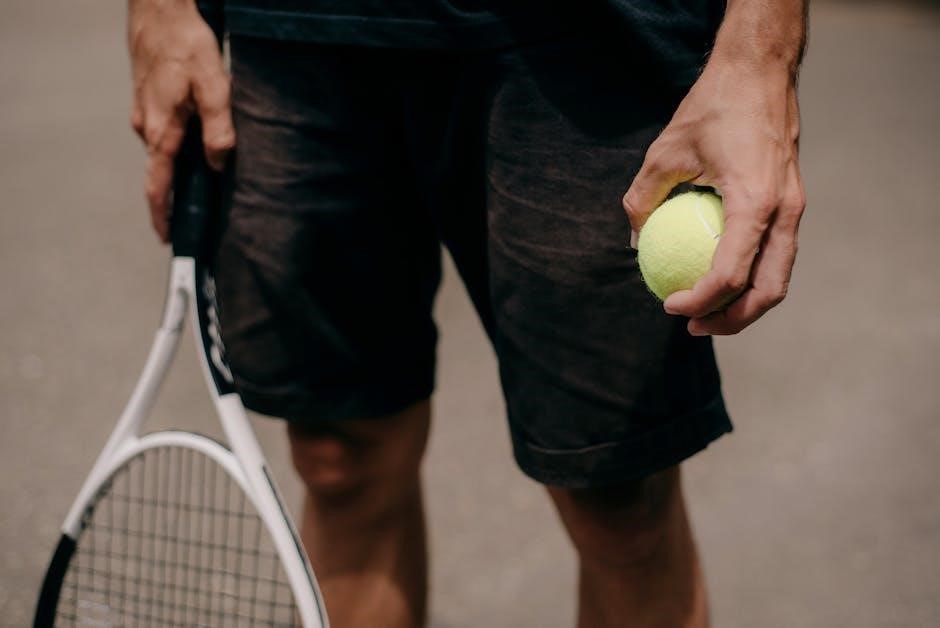Choosing the right tennis racket grip size is crucial for comfort, control, and performance. This guide explains how to measure, select, and customize your grip for optimal play.
Importance of Choosing the Correct Grip Size
Choosing the correct grip size is essential for comfort, control, and performance. A proper fit prevents strains and injuries, ensuring the racket feels natural in your hand. A grip that’s too small requires more strength, potentially causing fatigue, while a grip that’s too large can reduce control and precision. The right size allows for optimal torque and reduces the risk of twisting during shots. Personal preference also plays a role, as some players adjust their grip size over time or use overgrips for customization. Proper fit enhances overall playing experience and longevity.
Overview of Tennis Racket Grip Size Measurement
Tennis racket grip sizes are measured using a combination of numbering systems and physical measurements. The most common methods include the 1-5 numbering system, where higher numbers indicate larger grips, and the American inch measurement method, which specifies sizes in fractions of an inch. Additionally, the ruler test is a practical approach, involving measuring the hand from the tip of the ring finger to the palm. These methods ensure accuracy and help players find a grip size that balances comfort and performance, whether they’re a junior, amateur, or professional player.

How Tennis Racket Grip Sizes Are Measured
Tennis racket grip sizes are measured using a numbered system (1-5) and American inch measurements. The ruler test and ring finger-to-palm measurement are common methods for accuracy.
Grip Size Numbering System (1-5)
The grip size numbering system ranges from 1 to 5, with each number corresponding to a specific circumference. A size 1 grip is the smallest, while a size 5 is the largest. This system helps standardize measurements across manufacturers, making it easier for players to choose the right size. The numbering system is widely used and provides a clear reference point for determining the appropriate grip size based on hand measurements and personal preference.
American Inch Measurement Method
The American inch measurement method is another way to determine grip size, often used alongside the numbering system. Grip sizes are measured in inches, typically ranging from 4 to 5 inches in circumference. This method provides precise measurements, allowing players to find a grip that fits comfortably. By measuring the circumference of the handle, players can ensure a proper fit, which is essential for control and comfort during play. This method is particularly useful for those who prefer more exact measurements.
Understanding the Ruler Test for Grip Size
The ruler test is a simple method to determine grip size without a racket. Hold your dominant hand open with fingers extended. Align a ruler vertically against your ring finger, measuring from the tip to the second crease in your palm. This measurement corresponds to your grip size. Ensure the ruler is straight and your hand is flat for accuracy. This method is ideal for those without access to a racket, providing a reliable way to find the perfect fit for comfort and performance.

Methods to Determine Your Grip Size
Measure your grip size using the handshake method, ring finger to palm measurement, or a ruler. These methods ensure a comfortable and accurate fit for optimal performance.
The Handshake Method
The handshake method is a simple way to determine grip size. Hold the racket like a handshake, with your index finger able to fit between your hand and fingers. A proper fit allows slight space, ensuring comfort and control. If the grip feels too small, you can add overgrips. This method prioritizes a snug yet comfortable feel, reducing the risk of twisting and injury. It’s a practical approach for players of all levels to find their ideal grip size quickly and effectively.
The Ring Finger to Palm Measurement
The ring finger to palm measurement is a precise method to determine grip size. Measure the distance from the tip of your ring finger to the middle of your palm. This length corresponds to the ideal grip size, ensuring a balance between control and comfort. A proper fit prevents excessive twisting and reduces injury risk. This method is highly recommended for accuracy and is often used by professionals to customize their rackets for optimal performance and comfort during play.
Using a Ruler for Accurate Measurement
To measure your grip size with a ruler, hold your dominant hand open with fingers extended. Align the ruler vertically against your ring finger, measuring from the tip to the second crease in your palm. This method provides an accurate gauge for determining your ideal grip size. It’s a reliable technique for customization, ensuring comfort and control. If unsure, start with a smaller size, as overgrips can always be added to increase the grip size for a better fit.

Impact of Grip Size on Performance
The right grip size optimizes torque, control, and comfort, reducing muscle fatigue and preventing injuries like tennis elbow. Proper fit ensures peak performance and precise strokes.
Torque and Control in Different Grip Sizes
Grip size significantly impacts torque and control. A larger grip allows more torque, reducing racket twisting during strokes, especially in volleys. Smaller grips provide precise control but may lack stability. The distance from the palm to the point of force application affects torque; larger grips increase this distance, enhancing control. Proper fit ensures optimal performance, balancing power and precision. Players with stronger hands may prefer larger grips for added torque, while those prioritizing finesse opt for smaller sizes. Grip size directly influences stroke consistency and overall play effectiveness.
Comfort and Reduced Risk of Injury
A properly fitted grip size enhances comfort and reduces the risk of injuries like tennis elbow and wrist strain. A grip that’s too small can cause excessive hand movement, leading to discomfort and fatigue. Conversely, a grip that’s too large may restrict finger movement, affecting control. Clinicians often recommend adjusting grip size to alleviate muscle fatigue and prevent injuries. Using overgrips can customize the fit, providing additional cushioning and support. Ensuring the right grip size is essential for long-term comfort and injury prevention, allowing players to perform at their best.
Personal Preference and Its Role in Grip Size Selection
Personal preference plays a significant role in choosing a grip size, as it directly impacts how a player feels the racket. Some players prefer a smaller grip for better control, while others opt for a larger size to reduce hand movement. Factors like hand size, playing style, and even weather conditions influence these choices. Many players customize their grips with overgrips to achieve the perfect feel. Ultimately, the right grip size is one that balances comfort, control, and confidence, allowing players to perform at their best on the court.

Grip Size by Demographics
- Juniors (under 11) typically use L0 or L1 grip sizes.
- Women generally prefer L1 or L2 sizes for better control.
- Men often opt for L2 or larger for improved power and stability.
Juniors and Grip Size Recommendations
Juniors under 11 typically use L0 or L1 grip sizes, ensuring proper control and comfort. Measure by aligning a ruler with the ring finger to the palm’s base. Smaller grips allow for better handling and technique development. As juniors grow, their grip size may increase. Parents should monitor fit to prevent discomfort or injury. Proper sizing helps young players develop a strong foundation for their game. Always test and adjust as needed to ensure optimal performance and comfort.
Women’s Preferred Grip Sizes
Women generally prefer grip sizes L1 or L2, which provide comfort and control. Measure by aligning a ruler from the tip of the ring finger to the palm’s base. Proper sizing reduces injury risk and enhances performance. Some women use overgrips to customize fit further. Ensure the grip feels natural and allows for a firm but not overly tight hold. Testing different sizes can help determine the best fit for individual hand sizes and playing styles.
Men’s Grip Size Preferences
Men typically prefer larger grip sizes, often L2 or L3, which suit average to larger hands. Measure by aligning a ruler from the tip of the ring finger to the palm’s base. Proper sizing enhances control and reduces twisting. Some men opt for L4 for added torque, especially in modern play. Personal preference varies, but ensuring a comfortable fit is key. Overgrips can fine-tune the size for optimal feel. Testing different sizes helps determine the best fit for individual hand sizes and playing styles.

Grip Size and Personal Preference
Grip size is a matter of personal preference, influenced by hand size, comfort, and playing style. Players often adjust sizes over time for better feel and performance.
Why Grip Size May Change Over Time
Grip size preferences can evolve due to hand growth, especially in juniors, or changes in playing style. Comfort and performance needs may shift over time, prompting adjustments. Some players find smaller grips offer better control, while others prefer larger sizes for reduced slippage, particularly in sweaty conditions. Injuries or muscle fatigue may also lead to reevaluating grip size for better support. Ultimately, grip size is not static and may change as a player’s needs and preferences develop.
Adjusting to Larger or Smaller Grip Sizes
Adjusting to a larger or smaller grip size can enhance comfort and performance. A larger grip may reduce slippage, especially in sweaty conditions, while a smaller grip offers better control. Players often customize by adding overgrips or heat sleeves to build up the handle. It’s easier to increase grip size than decrease it, so starting small and adding layers is recommended. Testing different sizes during practice helps determine the ideal fit, ensuring optimal performance and reducing injury risks.
Thin vs. Thick Overgrips for Customization
Thin overgrips provide a subtle increase in grip size, maintaining a sleek feel while offering better control. Thick overgrips add significant bulk, reducing slippage and absorbing sweat, ideal for larger hands or sweaty conditions. Players often combine thin base grips with thick overgrips for a tailored fit. This customization allows for precise adjustments, ensuring comfort and performance without altering the racket’s original size, making it a practical solution for personalizing grip size to individual preferences and playing styles.
Using Overgrips for Added Comfort
Overgrips enhance comfort by reducing slippage and absorbing sweat, especially in hot conditions. They allow customization without altering the racket’s original grip size, catering to individual preferences.
How Overgrips Can Adjust Grip Size
Overgrips provide a practical solution to customize your racket’s grip size; By adding layers of thin or thick overgrips, players can increase or fine-tune their handle size. This method is ideal for those who prefer a slightly larger grip without committing to a new racket. Overgrips also reduce slippage and absorb moisture, enhancing comfort during play. They can be easily replaced when worn out, making them a versatile option for adjusting grip size to suit individual preferences and playing conditions.
When to Replace Overgrips
Overgrips should be replaced when they show signs of wear, such as fraying, thinning, or loss of tackiness. If the grip becomes slippery or uncomfortable, it’s time for a change. Players should also replace overgrips after prolonged use or if they notice reduced performance. Regularly updating overgrips ensures consistent grip quality, preventing issues like hand slippage during matches. This simple maintenance step can significantly impact comfort and control, making it a crucial part of racket care.
Building Up Grip Size for Better Fit
Building up grip size is a practical solution for players seeking a more customized fit. Overgrips or heat sleeves can be added to increase thickness, enhancing comfort and control. This method is ideal for those with larger hands or preferences for a thicker feel. By layering materials, players can achieve their desired grip size without replacing the racket. This approach is particularly useful for juniors transitioning to adult sizes or for adapting to different playing conditions. It ensures optimal performance and reduces the risk of discomfort or injury during play.

Health Considerations and Grip Size
Proper grip size reduces injury risks like tennis elbow and wrist strain. A well-fitted handle minimizes muscle fatigue and prevents the racket from twisting during play, ensuring comfort and safety.
Grip Size and Tennis Elbow Prevention
Proper grip size plays a significant role in preventing tennis elbow, a common injury among players. A grip that is too small can cause overgripping, leading to increased strain on the forearm and wrist. Research indicates that larger grip sizes may reduce the risk of tennis elbow by distributing pressure more evenly. Clinicians often recommend adjusting grip size to alleviate symptoms, as improper fit can contribute to muscle fatigue and tendon strain. Ensuring the right fit helps minimize the risk of injury and promotes long-term comfort during play.
Wrist Injuries and Grip Size
Wrist injuries in tennis are often linked to improper grip sizes. A grip that is too small can cause excessive wrist movement, increasing the risk of strain. Conversely, a grip that is too large may limit flexibility, leading to awkward strokes. Studies suggest that players using grips tailored to their hand size experience fewer wrist injuries. Proper fit ensures better control and reduces unnatural wrist positioning, minimizing injury risks during forehand and other strokes. Customizing grip size can help protect the wrist and enhance overall performance.
Muscle Fatigue and Grip Size
Improper grip size can lead to muscle fatigue, as it alters the natural movement and strain on the forearm and hand muscles. A grip that is too small requires more strength to maintain control, while a grip that is too large can cause awkward positioning. Research shows that muscle firing patterns in the forearm are affected by grip size, potentially leading to fatigue and injury. Clinicians often recommend adjusting grip size to reduce muscle strain and prevent conditions like tennis elbow. Proper fit ensures efficient energy use and minimizes fatigue during play.
Professional Tennis Players’ Grip Preferences
Pros often prefer specific grip sizes for optimal control and performance. Many customize their grips with overgrips to reduce twisting and enhance comfort during intense matches.
Common Grip Sizes Among Pros
Professional tennis players often use grip sizes that balance control and power. Men typically prefer sizes L2 to L3, while women commonly use L1 to L2. For example, Federer uses L3, and Serena Williams prefers L1. Juniors usually opt for smaller sizes like L0 or L1. These sizes allow pros to maintain precise control during intense matches while minimizing hand fatigue. Customization with overgrips is also common, enabling players to tailor their grip to personal comfort and performance needs.
How Pros Customize Their Grips

Professional players often customize their grips to enhance performance and comfort. Many use thin or thick overgrips to adjust the size, preventing slippage and reducing fatigue. Some apply heat sleeves to modify the handle’s thickness, while others prefer specific textures for better feel. Customization allows pros to tailor their grip to suit their playing style, whether it’s for added control, reduced vibration, or improved spin generation. These adjustments are crucial for maintaining consistency and peak performance during high-level competition.
Measuring Grip Size Without a Racket
Without a racket, measure your grip size using a ruler. Align it vertically against your ring finger, from the tip to the second crease in your palm for accuracy.
To measure your grip size without a racket, use a ruler. Open your dominant hand with fingers extended and aligned closely. Place the ruler vertically against your ring finger, measuring from the tip to the second crease in your palm. This length corresponds to your grip size. Ensure your hand is flat and fingers are together for accuracy. The standard sizes range from 4 to 4 5/8 inches. This method provides a reliable way to determine your ideal grip size, ensuring comfort and optimal performance.
Alternative Methods for Grip Size Determination
Beyond using a ruler, alternative methods include the handshake test and measuring the space between your fingers and palm. The handshake method involves gripping the racket like a handshake, ensuring space between your fingers and palm. Another approach is comparing your hand size to standard grip charts. Some players also use trial and error with different grips to find comfort. These methods help determine the ideal size without precise tools, ensuring a comfortable and effective grip.
Grip Size Customization
Customizing grip size involves using heat sleeves or overgrips to tailor the fit. This allows players to adjust the size for comfort and performance without altering the racket itself.
Heat Sleeves and Their Impact
Heat sleeves are a popular method for customizing grip size. They are installed by heating the sleeve and sliding it onto the racket handle, creating a snug, personalized fit. This method allows players to increase grip size without the bulkiness of overgrips. Heat sleeves are durable and provide consistent grip thickness, enhancing control and comfort. They are particularly favored by players seeking a permanent solution to their grip size needs, offering both performance and aesthetic benefits. Proper installation ensures optimal results.
Customizing Grip Size for Individual Needs
Customizing grip size tailors the racket to individual preferences, enhancing comfort and performance. Players can adjust by adding overgrips or heat sleeves, allowing precise control over thickness. This personalization helps prevent injuries and improves technique. For example, those with smaller hands may prefer thinner grips, while larger hands benefit from thicker ones. Customization ensures the racket feels natural, optimizing play. It’s a simple yet effective way to meet specific needs, making each racket unique to its user.

Advanced Techniques for Grip Size Selection
Advanced players optimize grip size for specific strokes, balancing spin, control, and comfort. Proper sizing reduces handle twisting, enhancing precision and power in volleys and groundstrokes.
Grip Size and Its Effect on Spin
Grip size significantly impacts a player’s ability to generate spin. A smaller grip allows for more wrist action, enabling sharper angles and heavier topspin. Conversely, a larger grip reduces wrist movement, making it harder to produce extreme spin. Players who rely on spin should opt for a smaller grip size, while those prioritizing control may prefer a larger one. Balancing grip size with technique ensures optimal spin generation and shot consistency.
Grip Size and Volleys
Grip size plays a crucial role in volley performance. A larger grip reduces handle twisting, providing stability and control during volleys. Players with larger hands often prefer this setup, as it enhances precision at the net. Conversely, a smaller grip allows for quicker wrist movements, enabling sharper angles and faster reactions. The right grip size balances stability and maneuverability, ensuring consistent volley execution. Proper fit is essential for optimal performance in high-pressure net plays.
Grip Size and Forehand Strokes
Grip size significantly impacts forehand strokes, affecting power, spin, and control. A larger grip reduces handle twisting, enhancing stability and consistency. Smaller grips allow more wrist movement, enabling sharper spins and precise shots. Proper fit prevents discomfort and injury, as improper sizing can strain the wrist during repetitive forehand motions. Balancing grip size with hand size ensures optimal performance, allowing players to execute forehands with confidence and accuracy. The right grip size tailors to individual stroke styles, maximizing efficiency and reducing fatigue.
Choosing the right grip size is essential for comfort, control, and performance. Proper fit ensures optimal play, while customization options like overgrips help tailor the grip to individual needs.
Final Tips for Choosing the Right Grip Size
Measure your hand accurately using the ruler test or handshake method to ensure a proper fit. Prioritize comfort and control, as these directly impact performance. If unsure, opt for a smaller size, as overgrips can add thickness. Consider personal preferences, such as thin or thick overgrips, to customize your grip. Test different sizes if possible, and remember that grip size may change over time due to hand growth or playing style adjustments. Proper fit reduces injury risk and enhances overall play.
Importance of Proper Grip Size for Optimal Performance
A well-fitted grip size is essential for maximizing performance and comfort on the court. It ensures better control, reduces muscle fatigue, and minimizes the risk of injuries like tennis elbow. A grip that’s too small can cause the racket to twist in your hand, while one that’s too large may limit your ability to generate power and precision. Proper fit allows for optimal torque and stroke consistency, enabling you to play at your best. Prioritizing the right grip size is key to unlocking your full potential and enjoying the game.
Additional Resources
Explore further with online tools and guides for precise grip size measurement. Visit https://www.friscotennisstringing.com/ and https://tenniscompanion.org/ for expert advice and customization tips.

Recommended Reading for Further Information
For deeper insights, visit https://www.friscotennisstringing.com/ and tenniscompanion.org. These resources offer expert guides on grip size selection, customization, and injury prevention. Explore video tutorials, detailed measurement techniques, and tips for optimizing your racket’s fit. Additionally, tenniscompanion.org provides comprehensive articles on how grip size affects performance and comfort. These platforms are essential for players seeking to enhance their game through proper equipment setup and maintenance.
Online Tools for Grip Size Measurement
Utilize online tools like https://www.friscotennisstringing.com/ and tenniscompanion.org for precise grip size measurement. These platforms offer interactive guides, video tutorials, and detailed instructions to help determine your ideal fit. Additionally, some websites provide virtual rulers and measurement charts to ensure accuracy. Explore these resources to enhance your understanding of grip size customization and maintenance, ensuring optimal comfort and performance on the court.